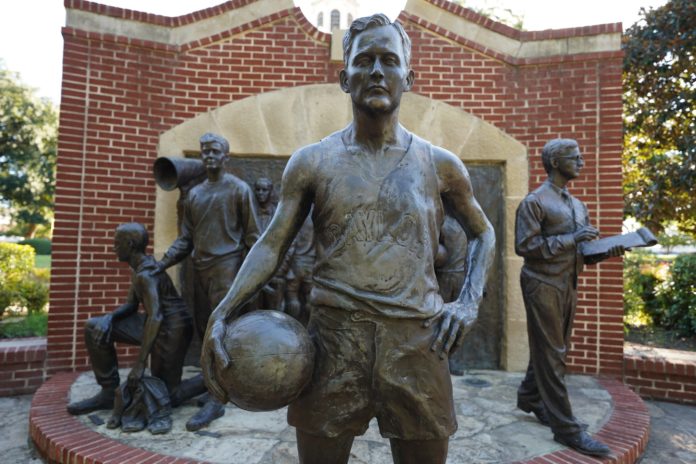
By Ava Dunwoody | Staff Writer
Baylor’s basketball team headed for Austin on a bus that would later be hit by an oncoming train at 8:30 a.m. on Jan. 22, 1927, killing 10 young men. Their story is passed down even 93 years later to each freshman class as an example of the eternal Baylor spirit shown by the legacy of the Immortal Ten.
Dr. Todd Copeland, Baylor director of advancement marketing, decided to write a comprehensive account of the accident in his book “The Immortal Ten: The Definitive Account of the 1927 Tragedy and its Legacy at Baylor University.” During his research, Copeland said he got to see firsthand the lasting impact of the accident.
“The thing that impressed me,” Copeland said, “was how much this was not just a Baylor story, but it was a Waco story and a Texas story.”
Through his research, Copeland read letters and heard testimonies from survivors, victims and their families. He said he pulled articles published at that time and collected many accounts to bring out “the human side of the story,” focusing heavily on the legacy left behind after tragedy struck.
When news of the crash was heard on campus, Baylor President Samuel Palmer Brooks said to the press “the heart of Baylor University is torn to shreds at this moment.”
Memorial events were held in lieu of school the next Monday and all basketball games were canceled for the season. Over 3,000 people showed up to a memorial service held on Baylor’s basketball court that day to mourn the Immortal Ten.
“Baylor was a small school at that time,” survivor Dave Cheavens said later in 1970. “Everybody knew personally the athletes who were killed. It left the campus paralyzed. The emotional impact of something like that — you just can’t recover from it. You remember sitting in class with those fellows, and the next week you go to class, and they aren’t there. It’s quite a feeling.”
Cheavens was often asked to speak of his experience later when he became chairman of Baylor’s journalism department. The other survivors also went on to graduate from Baylor and work as coaches, teachers and prominent leaders of Waco.
The victims, too, left behind an important legacy through new legislation that came after the crash. At the state capital, the Texas flag was flown at half staff to honor the Immortal Ten, who the Texas House of Representatives said were “worthy in every way to be acclaimed true sons of those great spirits who died at the Alamo and Goliad.”
The first railway overpass in the state of Texas, Mays Street Bridge in Round Rock, was built and dedicated to the Immortal Ten at the very intersection of the crash eight years later. In the meantime, many highways were relocated to eliminate railway crossings around the state.
At Baylor, the Immortal Ten live on as well. Every basketball season, there is one game dedicated to the tragedy where players wear the names of the Immortal Ten on the back of their jerseys. Jack Castellaw’s mother donated the funds to build Castellaw Communications Center in memory of her son. Even the Baylor class ring depicts a railroad spike on the side to pay tribute to their legacy.
In 2007, Bruce Greene crafted the bronze statues of the Immortal Ten found on Baylor’s campus near the SUB. The idea for the monument began when Chase Palmer, 1996 senior class president, announced that they would begin using class gift funds to save for an Immortal Ten statue. Now the monument stands with Clyde “Abe” Kelley in front, basketball on hip, leading his team to eternity.
“Without the story being told,” Copeland said, “I think the memorial wouldn’t have a lot of meaning. It could just be another statue people walk by and don’t know anything about or have a particular bond with.” That is why, he said, the next tradition is the most important.
What started from the 1928 memorial became what is now the annual Freshmen Mass Meeting, which is held at 10 p.m. during one night every Homecoming Week. Here, the Chamber of Commerce — who Copeland calls the “guardian of the Immortal Ten story” — tells the freshmen class the story of the tragedy and represents each of the players with an empty chair on the basketball court.
Neil Knighton, 1975 Baylor graduate, has spoken at many Mass Meetings and is often charged with sharing the story.
“The hero is the spirit of Baylor tradition,” Knighton said. “What we celebrate is acknowledging one another as important. Tradition is bound up in our relationships that we carry on for a lifetime. The stories help us enhance those relationships. That is the Baylor tradition.”
Copeland said as long as the Mass Meeting continues, he believes the story of the Immortal Ten will live on. He said it is a story that “demonstrates the sense of community that flows through the Baylor family, both back then and now,” and it stands as a reminder of the support offered to each member of it.
“I think it’s particularly relevant for college kids, especially college freshman, to hear this story,” Copeland said. “It’s a reminder to treasure every day that God gives us to be alive because none of us know when that will end, and it will end. We need to do as much with our lives as we can. I think that’s the other part of the story that is relevant today, and it still matters.”





